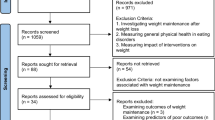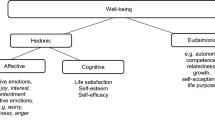Abstract
Purpose
To evaluate the effects of a Multidisciplinary Obesity Treatment Program (PMTO) on parent-proxy perceptions and self-reported health-related quality of life (HRQoL) in overweight and obese adolescents.
Methods
Ninety-two overweight and obese adolescents aged 10–18 years were assigned to the PMTO. HRQoL was assessed with the Pediatric Quality of Life Inventory (PedsQLTM 4.0), administered to the adolescents and their parents/guardians at baseline and post-intervention. This intervention lasted 16 weeks and was based on cognitive behavioral therapy with the involvement of a psychologist, a nutritionist and exercise professionals.
Results
Adolescents reported improved physical [pre: 78.13 (21.1) to post: 84.38 (18.8); p < 0.001; effect size: 0.43], social [pre: 80.0 (30.0) to post: 85.0 (20.0); p = 0.033; effect size: 0.10], psychosocial [pre: 75.0 (22.8) to post: 76.67 (19.6); p = 0.013; effect size: 0.18], and total [pre: 75.0 (17.4) to post: 79.35 (16.8); p = 0.001; effect size: 0.28] domain scores. As for parent-proxy perceptions, improvements for all domains, except school domain, were noted (p < 0.05; effect sizes: from 0.26 to 0.34) post-intervention. At baseline, parents presented lower scores than the adolescents’ HRQoL for all domains (p < 0.05). However, following the intervention, parents only had lower scores than their children for the physical and total domains of the HRQoL scale.
Conclusions
In addition to improving HRQoL in the adolescents, the PMTO improved parent-proxy perceptions of their children’s HRQoL.



Similar content being viewed by others
Abbreviations
- BMI:
-
Body mass index
- ES:
-
Effect size
- HRQoL:
-
Health-related quality of life
- PMTO:
-
Multidisciplinary obesity treatment program
- WC:
-
Waist circumference
- HC:
-
Hip circumference
References
Ng M, Fleming T, Robinson M, Thomson B, Graetz N, Margono C, Mullany EC, Biryukov S, Abbafati C, Abera SF, Abraham JP, Abu-Rmeileh NM, Achoki T, AlBuhairan FS, Alemu ZA, Alfonso R, Ali MK, Ali R, Guzman NA, Ammar W, Anwari P, Banerjee A, Barquera S, Basu S, Bennett DA, Bhutta Z, Blore J, Cabral N, Nonato IC, Chang JC, Chowdhury R, Courville KJ, Criqui MH, Cundiff DK, Dabhadkar KC, Dandona L et al (2014) Global, regional, and national prevalence of overweight and obesity in children and adults during 1980–2013: a systematic analysis for the Global Burden of Disease Study 2013. Lancet 384(9945):766–781
Pulgarón ER (2013) Childhood obesity: a review of increased risk for physical and psychological comorbidities. Clin Ther 35(1):A18–A32
Zametkin AJ, Zoon CK, Klein HW, Munson S (2004) Psychiatric aspects of child and adolescent obesity: a review of the past 10 years. J Am Acad Child Adolesc Psychiatry 43(2):134–150
Østbye T, Malhotra R, Wong HB, Tan SB, Saw SM (2010) The effect of body mass on health-related quality of life among Singaporean adolescents: results from the SCORM study. Qual Life Res 19(2):167–176
Morano M, Rutigliano I, Rago A, Pettoello-Mantovani M, Campanozzi A (2016) A multicomponent, school-initiated obesity intervention to promote healthy lifestyles in children. Nutrition 32(10):1075–1080
Bocca G, Kuitert MW, Sauer PJ, Stolk RP, Flapper BC, Corpeleijn E (2014) A multidisciplinary intervention programme has positive effects on quality of life in overweight and obese preschool children. Acta Paediatr 103(9):962–967
Fullerton G, Tyler C, Johnston CA, Vincent JP, Harris GE, Foreyt JP (2007) Quality of life in Mexican–American children following a weight management program. Obes 15:2553–2556
Hofsteenge GH, Weijs PJ, Delemarre-van de Waal HA, de Wit M, Chinapaw MJ (2013) Effect of the Go4it multidisciplinary group treatment for obese adolescents on health related quality of life: a randomised controlled trial. BMC Public Health 13:939
Vos RC, Huisman SD, Houdijk EC, Pijl H, Wit JM (2012) The effect of family-based multidisciplinary cognitive behavioral treatment on health-related quality of life in childhood obesity. Qual Life Res 21(9):1587–1594
Lofrano-Prado MC, Antunes HK, do Prado L, de Piano A, Caranti DA, Tock L, Carnier J, Tufik S, de Mello MT, Dâmaso AR (2009) Quality of life in Brazilian obese adolescents: effects of a long-term multidisciplinary lifestyle therapy. Health Qual Life Outcomes 7:61–68
Hughes AR, Stewart L, Chapple J, McColl JH, Donaldson MD, Kelnar CJ, Zabihollah M, Ahmed F, Reilly JJ (2008) Randomized, controlled trial of a best-practice individualized behavioral program for treatment of childhood overweight: Scottish Childhood Overweight Treatment Trial (SCOTT). Pediatrics 121(3):e539–e546
Wille N, Erhart M, Petersen C, Ravens-Sieberer U (2008) The impact of overweight and obesity on health-related quality of life in childhood–results from an intervention study. BMC Public Health 8:421
Steele RG, Gayes LA, Dalton WT, Smith C, Maphis L, Conway-Williams E (2016) Change in health-related quality of life in the context of pediatric obesity interventions: a meta-analytic review. Health Psychol 35(10):1097–1109
Varni JW, Seid M, Kurtin PS (2001) PedsQL 4.0: reliability and validity of the Pediatric Quality of Life Inventory version 4.0 generic core scales in healthy and patient populations. Med Care 39(8):800–812
Klatchoian DA, Len CA, Terreri MT, Silva M, Itamoto C, Ciconelli RM, Varni JW, Hilário MO (2008) Quality of life of children and adolescents from São Paulo: reliability and validity of the Brazilian version of the Pediatric Quality of Life Inventory version 4.0 Generic Core Scales. J Pediatr 84(4):308–315
Bianchini JA, da Silva DF, Nardo CC, Carolino ID, Hernandes F, Nardo Junior N (2013) Parent-proxy perception of overweight adolescents’ health-related quality of life is different according to adolescent gender and age and parent gender. Eur J Pediatr 172(10):1371–1377
Gandhi PK, Revicki DA, Huang IC (2015) Adolescent body weight and health-related quality of life rated by adolescents and parents: the issue of measurement bias. BMC Public Health 30(15):1192
Kunkel N, Oliveira WF, Peres MA (2009) Overweight and health-related quality of life in adolescents of Florianópolis, Southern Brazil. Rev Saúde Pública 43(2):226–235
Wafa SW, Talib RA, Hamzaid NH, McColl JH, Rajikan R, Ng LO, Ramli AH, Reilly JJ (2011) Randomized controlled trial of a good practice approach to treatment of childhood obesity in Malaysia: Malaysian Childhood Obesity Treatment Trial (MASCOT). Int J Pediatr Obes 6(2–2):e62–e69
Cooper Z, Fairburn CG, Hawker DM (2003) Cognitive–behavioral treatment of obesity. The Guildford Press, New York
Katzmarzyk PT, Barlow S, Bouchard C, Catalano PM, Hsia DS, Inge TH, Lovelady C, Raynor H, Redman LM, Staiano AE, Spruijt-Metz D, Symonds ME, Vickers M, Wilfley D, Yanovski JA (2014) An evolving scientific basis for the prevention and treatment of pediatric obesity. Int J Obes 38(7):887–905
Cole TJ, Lobstein T (2012) Extended international (IOTF) body mass index cut –offs for thinness, overweight and obesity. Pediatr Obes 7(4):284–294
Da Silva DF, Bianchini JA, Lopera CA, Capelato DA, Hintze LJ, Nardo CC, Ferraro ZM, Nardo Junior N (2015) Impact of readiness to change behavior on the effects of a multidisciplinary intervention in obese Brazilian children and adolescents. Appetite 87:229–235
Tanner JM (1986) Normal growth and techniques of growth assessment. J Clin Endocrinol Metab 15:411–451
Heyward VH (2001) ASEP methods recommendation: body composition assessment. J Exerc Physiol 4:1–12
Cohen J (1988) Statistical power analysis for the behavioral sciences. Lawrence Erlbaum, Hillsdale
Nikolaidis PT (2011) Familial aggregation and maximal heritability of exercise participation: a cross-sectional study in schoolchildren and their nuclear families. Sci Sports 26:157–165
Brosse AL, Sheets ES, Lett HS, Blumenthal JA (2002) Exercise and the treatment of clinical depression in adults: recent findings and future directions. Sports Med 32(12):741–760
Melnyk BM, Small L, Morrison-Beedy D, Strasser A, Spath L, Kreipe R, Crean H, Jacobson D, Van Blankenstein S (2006) Mental health correlates of healthy lifestyle attitudes, beliefs, choices, and behaviors in overweight adolescents. J Pediatr Health Care 20(6):401–406
Pinhas-Hamiel O, Singer S, Pilpel N, Fradkin A, Modan D, Reichman B (2006) Health-related quality of life among children and adolescents: associations with obesity. Int J Obes 30(2):267–272
Zeller MH, Modi AC (2006) Predictors of health-related quality of life in obese youth. Obes 14(1):122–130
Lopera CA, da Silva DF, Bianchini JA, Locateli JC, Moreira AC, Dada RP, Thivel D, Junior Nardo N (2016) Effect of water- versus land-based exercise training as a component of a multidisciplinary intervention program for overweight and obese adolescents. Physiol Behav 165:365–373
Kolotkin RL, Zeller M, Modi AC, Samsa GP, Quinlan NP, Yanovski JA, Bell SK, Maahs DM, de Serna DG, Roehrig HR (2006) Assessing weight related quality of life in adolescents. Obes Res 14:448–457
Torres-Luque G, Beltrán J, Calahorro F, López-Fernández I, Nikolaidis PT (2016) Analysis of the distribution of physical activity in early childhood education students. Cuad Psicol Deporte 16(1):261–267
Janicke DM, Steele RG, Gayes LA, Lim CS, Clifford LM, Schneider EM, Carmody JK, Westen S (2014) Systematic review and meta-analysis of comprehensive behavioral family lifestyle interventions addressing pediatric obesity. J Pediatr Psychol 39(8):809–825
Etelson D, Brand DA, Patrick PA, Shirali A (2003) Childhood obesity: do parents recognize this health risk? Obes Res 11:1362–1368
Elia M (2004) Obesity: what does it represent? Asia Pac J Clin Nutr 13:S34
Acknowledgements
The authors thank the members of the Multiprofessional Nucleus of Obesity Treatment program for their contributions to data collection and intervention development. The authors would also like to thank the Araucaria Foundation, Capes, and the Brazilian Ministry of Health for financial support and scholarships. This study was funded by Araucaria Foundation (agreement 179/10, protocol 19213).
Author information
Authors and Affiliations
Corresponding author
Ethics declarations
Conflict of interest
The authors declare that they have no conflict of interest.
Ethical standard
This study was approved by the local Ethics Committee (protocol 463/2009). All procedures performed in studies involving human participants were in accordance with the ethical standards of the institutional and/or national research committee and with the 1964 Helsinki declaration and its later amendments or comparable ethical standards.
Informed consent
Informed consent was obtained from all individual participants included in the study.
Rights and permissions
About this article
Cite this article
Bianchini, J.A.A., da Silva, D.F., Dada, R.P. et al. Improvements in self-reported and parent-proxy perceptions of adolescents’ health-related quality of life following a multidisciplinary obesity treatment program. Sport Sci Health 13, 131–137 (2017). https://doi.org/10.1007/s11332-016-0341-6
Received:
Accepted:
Published:
Issue Date:
DOI: https://doi.org/10.1007/s11332-016-0341-6




